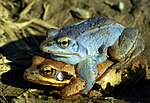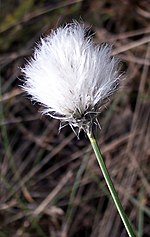Fürstenkuhle
|
Fürstenkuhle nature reserve
|
||
|
The Fürstenkuhle in the Heubach lowlands . |
||
| location | Gescher , Kreis Borken , NRW , Germany | |
| surface | 99 ha | |
| Identifier | BOR-019 | |
| WDPA ID | 81699 | |
| Natura 2000 ID | DE4008302 | |
| FFH area | 87 hectares | |
| Geographical location | 51 ° 54 ' N , 7 ° 3' E | |
|
|
||
| Sea level | 65 m | |
| Setup date | 1942 | |
| Framework plan | Landscape plan "Gescher" from February 25, 2004 | |
| administration | Borken district | |
| particularities | Significant moor frog population . | |
The Prince Kuhle is an approximately 99 hectare nature conservation and an approximately 87-hectare FFH area in the city of Gescher , near the hamlet of bog in the district of Borken .
General
The Fürstenkuhle, located on the edge of the Heubach lowland , is like the nearby Kuhlenvenn a remnant of the White Fens . The White Fens between Velen and Coesfeld was the largest moorland in Westphalia until the middle of the 20th century . Today it is largely drained, pitted and cultivated . The Fürstenkuhle is a raised bog with a central , large heather pond surrounded by broken forest . In places, typical raised bog vegetation has been preserved. The forest area is surrounded by extensively used grassland and wet meadows with some artificially created blanks that are visited by resting and breeding birds. The flora and fauna of the heather pond and its surroundings are unique in North Rhine-Westphalia .
The name Fürstenkuhle comes from the Low German word Voskenkuhle (= fox hole ), so it has nothing to do with a prince.
The Fürstenkuhle was declared a nature reserve in 1942 (identifier BOR-019) and is subject to the Gescher landscape plan of February 25, 2004, the primary objective of which is to "restore a living bog through regeneration of the natural water balance".
flora
The nature reserve is endowed with a rich flora. In the marginal areas of the dystrophic heather pond ( habitat type 3160, see list of FFH habitat types ) there are transitional and swinging turf bogs (LRT 7140) as well as wet (4010) and dry heather zones (4030). As typical representatives of the heather landscape , broom , bell and rosemary heather can be found here. The Schnabelriede is also at home in the siltation zones. The pond is whistling grass rich birch - Bruchwald surrounded.
The actual core of the nature reserve is formed by the degraded raised bogs (7120) that are still capable of being renatured and occupy 5.5 hectares of the area and are of particular importance. In addition, moorland pioneer societies have formed in old peat cuttings (7150). In these areas you can find typical raised bog plants, such as various peat mosses , round-leaved sundew and several cotton grasses . The layer of peat formed by the peat moss over time is up to 1.5 m thick.
fauna

The Fürstenkuhle is home to a significant moor frog population. The number of frogs, the males of which are often bright blue during the mating season, was estimated at up to 3000 adults in 2001. The little water frog is also at home in the Fürstenkuhle. There is also a small, highly endangered garlic toad population. Among reptiles , adder , forest lizard and slow worm are found in the nature reserve. The smooth snake , which is also native , could not be detected. The Fürstenkuhle and its wet meadows are an attractive destination for ducks , waders and meadow birds such as shoveler , teal , wood sandpiper , wood sandpiper , snipe and green thigh . Also Tufted , Canadian and Egyptian Goose were sighted. Golden oriole and reed warbler are native to the swamp forests near the water . As a migrant, the tree falcon makes a stop in the area. The insect fauna is rich. 32 dragonfly species were detected on the heather pond, 35 in the entire nature reserve, including the Great Moosjungfer , Great Blue Arrow , Vierfleck and Becher-Azurjungfer . Some rare species have been lost, such as the high moor mosaic maiden since 1985 , or are in decline, such as the spear and moon azure maiden , as the pond's vegetation has undergone a change: damage caused by feeding caused by muskrat and swimming birds disappeared with it Flood turf and flooding peat moss also provide the livelihoods for some species.
Measures to develop the area
In the course of the primary objective of the landscape plan the core portions were to the Heideweiher and the renaturation capable bog cells by the damming of Gräbeun and dismantling of drains rewetted and Entkusselungsmaßnahmen freed from aufwachsendem wood. In the agriculturally used outdoor areas, fertilization is dispensed with in order to prevent eutrophication, and wet meadows with blanks have been created. The adjacent grassland areas are only grazed extensively.
The path that begins on the Vennetütenweg (information board) was designed as a plank path over a total length of 160 m at the height of the Heideweiher in late autumn 2011 , which is controversial due to its massive construction with hot-dip galvanized railing supports. A footpath in the central area was blocked by placing crown wood in order to create resting areas for the animal world. This means that the previous circular route can no longer be fully committed.
Overall, the measures are not yet complete. The rewetting is to be pushed further. The living conditions for the moor frog and spadefoot toad populations are to be further improved in the spawning waters. Spruce stands that are atypical for their habitat are to be felled and the number of pines significantly reduced.
See also
Web links
- Fürstenkuhle and Kuhlenvenn (NaTourZeit). (PDF; 631 kB) State Institute for Ecology, Land Management and Forests NRW , accessed on April 24, 2011 .
- Natura 2000 area "Die Fürstenkuhle" in the specialist information system of the State Office for Nature, Environment and Consumer Protection in North Rhine-Westphalia
- Nature reserve “Fürstenkuhle” (BOR-019) in the specialist information system of the State Office for Nature, Environment and Consumer Protection in North Rhine-Westphalia
- Eberhard Schmidt: The Fürstenkuhle NSG in Gescher-Hochmoor. (PDF; 3.5 MB) An endangered raised bog from the perspective of the dragonfly fauna. In: Nature time. Naturschutzbund Deutschland (NABU), district associations in Münsterland, p. 12 f. , accessed February 3, 2012 .
References and comments
- ↑ a b c d "Fürstenkuhle" nature reserve in the specialist information system of the State Office for Nature, Environment and Consumer Protection in North Rhine-Westphalia , accessed on March 3, 2017.
- ↑ a b c d e f Natura 2000 area “Fuerstenkuhle im Weissen Venn” in the specialist information system of the State Office for Nature, Environment and Consumer Protection in North Rhine-Westphalia , accessed on March 11, 2017.
- ↑ The exhibition in the peat museum of Hochmoor is dedicated to the reclamation of the White Fens and the mining of the peat.
- ↑ a b c d e Eberhard Schmidt: The NSG Fürstenkuhle in Gescher-Hochmoor. (PDF; 3.5 MB) An endangered raised bog from the perspective of the dragonfly fauna. In: Nature time. Naturschutzbund Deutschland (NABU), district associations in Münsterland, p. 12 , accessed on February 7, 2012 .
- ↑ See Gescher landscape plan, section 2.1.3 "Fürstenkuhle" nature reserve ( page no longer available , search in web archives ) Info: The link was automatically marked as defective. Please check the link according to the instructions and then remove this notice.
- ↑ Fürstenkuhle in the White Fens. District of Borken, accessed on March 3, 2017 (action cards for download).
- ^ "Fürstenkuhle" nature reserve (habitats and species) in the specialist information system of the State Office for Nature, Environment and Consumer Protection in North Rhine-Westphalia , accessed on March 3, 2017.
- ↑ Dieter Glandt : Practical protective measures for the moor frog (Rana arvalis) and efficiency control in the “Fürstenkuhle” nature reserve, north-west Germany. (PDF; 340 kB) In: Zeitschrift für Feldherpetologie, Supplement August 13 , 2008, pp. 411–430 , accessed on February 7, 2012 .
- ↑ Thomas Mutz and Dieter Glandt : Artificial hiding places as a tool for field research on reptiles with special consideration of adder (Vipera berus) and smooth snake (Coronella austriaca). (PDF; 119 kB) In: Mertensiella 15. German Society for Herpetology and Terrarium Studies e. V., August 2008, pp. 186–196 , accessed February 7, 2012 .
- ↑ As (Venne-) Tü (g) te is mundartlich curlew bezeichnet.vgl. Elisabeth Piirainen and Wilhelm Elling: Dictionary of the West Munsterland dialect. (PDF; 3.9 MB) Heimatverein Vreden, p. 1185 , accessed on February 7, 2012 .
- ↑ Gescher-Blog: Reactions to the article “On plank paths through the Fürstenkuhle”.



